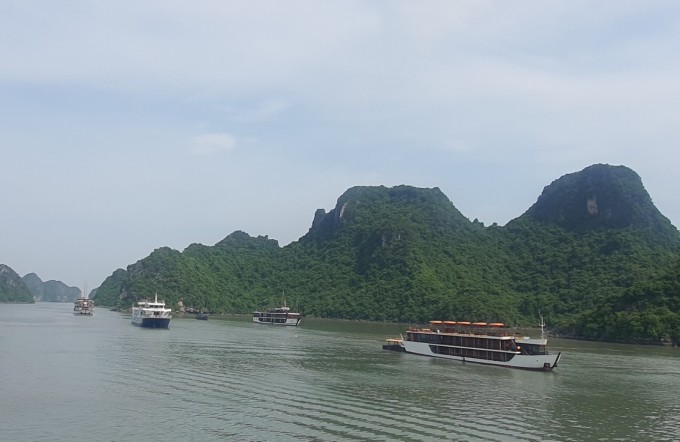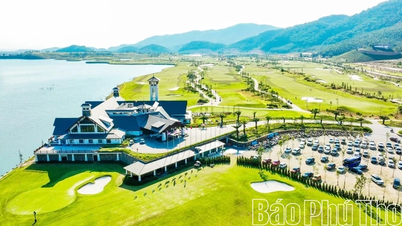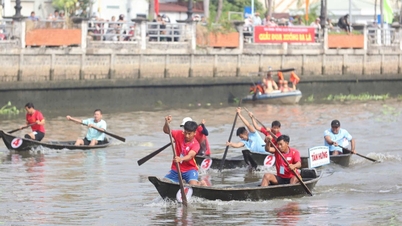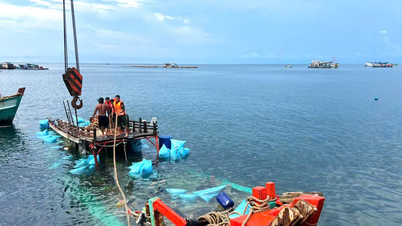Owners of tourist boats in Ha Long and Lan Ha bays said they lost hundreds of millions of dong due to storm Talim, hoping for more realistic forecasts, but experts assert that "forecasts cannot be completely accurate."
At the meeting of the National Steering Committee for Natural Disaster Prevention on the morning of July 17, two scenarios were presented regarding the landing of storm Talim. The first scenario (80% forecast) is that the storm will enter the area between Hai Phong and Quang Ninh, with circulation covering most of the North, Thanh Hoa and Nghe An, causing very heavy rain from the night of July 17 to July 20. The North will have about 200-400 mm of rain, with some places receiving over 500 mm; Thanh Hoa and Nghe An will have 100-200 mm, with some places receiving over 300 mm.
The second scenario (20%) is that after passing the Leizhou Peninsula (China), the storm will follow the Chinese coast and enter the border area of Mong Cai City with China. With this possibility, the rainfall will be less. Finally, this is the realistic scenario.

Cruise ship anchored at Gia Luan wharf, Hai Phong, July 17. Photo: Pham Ha
On the afternoon and evening of July 17, tourist boats in Ha Long Bay ( Quang Ninh ) and Lan Ha Bay (Hai Phong) were asked to return to the storm shelter, not to take tourists to visit the bay, and to stay overnight as scheduled. At 3:00 p.m. on July 18, the Quang Ninh Provincial Hydrometeorological Station issued a weather forecast for the night of July 18 and July 19, with wind levels of only 2-3 or 3-4, with light thunderstorms. The boats were able to operate. On July 18, the Hai Phong Inland Waterways Port Authority also issued a notice allowing boats to operate from 5:00 a.m. on July 19.
Although the storm has weakened, boat owners said they were severely affected by having to refund tourists, mostly foreigners with short stays in Vietnam. Some boat owners said they lost hundreds of millions of dong in a day. A representative of the Lan Ha Yacht Association said that the businesses under the unit have a total of about 800 rooms, so "the damage is huge".
A representative of a company that owns two cruise ships operating on both Ha Long Bay and Cat Ba Island said they had to resort to luck to make up for the previous day’s losses. They had told guests that July 19 would be “operating as normal,” before the announcement from the bay’s management board that the ban on ships would be lifted.
This unit commits not to collect any fees (including car travel and food expenses) if the bay management board has not allowed the boat to run. If the worst happens, the business will lose more money to compensate customers.
"We have lost money before because of this method, but we have to do it. I know a ship owner who lost money for another day because he did not accept any passengers today," this person said.
Although he knows that ensuring human safety in bad weather conditions is important, he still hopes that managers need to make more reasonable and practical decisions to minimize the impact on business units.
Mr. Long, another cruise ship owner who plies the Lan Ha Bay route, said the weather forecasting system is now more accurate than before. However, “that’s not enough” because business people need the most accurate forecasts and more “business-minded” decisions.
Responding to VnExpress , Ms. Le Thi Xuan Lan, former deputy head of the forecasting department of the Southern Hydrometeorological Station, said she "sympathizes with the suffering of businesses losing customers" during peak season, but also has to understand the decision from the management level.
Ms. Lan affirmed that Vietnam's weather forecasting system is "not outdated" although it cannot be compared with that of advanced countries. The State "has invested in many modern equipment" such as weather radar and satellite cloud images to support forecasting work. The forecasting level of forecasters may change over time "but not less".
She also said that Vietnam's forecast for Typhoon Talim is almost similar to that of countries like Japan, the US and Australia. However, it is necessary to understand that the typhoon "does not move like a car" but is also affected by many factors, so the forecast also needs to be updated continuously.
"We are lucky that the storm moved further up the Chinese mainland so the impact on Vietnam was not as severe. However, it must be emphasized that the energy of storm Talim is very terrible, equivalent to several hundred atomic bombs," Ms. Lan said, pointing out that if the storm "increased even a little bit", the Ha Long Bay area would be seriously affected.
This expert said that business people certainly do not like economic losses, especially during the peak tourist season. However, "in case ships are not banned from the bay and the forecast is correct, who will businesses blame?" According to Ms. Lan, when a storm comes, forecasters need to give the worst-case scenario to minimize damage to people and property.
Ms. Lan also cited the year 2013 when Haiyan - considered the deadliest storm in the history of the Philippines with at least 63,000 deaths - was about to make landfall, experts also said that this would be "the strongest storm in history". Many preventive and evacuation measures were implemented. All forecast models showed that the storm would enter Da Nang, pass through the central region, move north, the center of the storm passed through Hanoi and Ha Giang. However, many factors prevented the storm from having as great an impact as initially predicted.
"People and businesses need to understand that forecasts cannot be completely accurate; only 75% is considered correct. We need to follow the process and regulations of the law," she said.
Tu Nguyen
Source link


![[Photo] Bustling Mid-Autumn Festival at the Museum of Ethnology](https://vphoto.vietnam.vn/thumb/1200x675/vietnam/resource/IMAGE/2025/10/4/da8d5927734d4ca58e3eced14bc435a3)
![[Photo] Solemn opening of the 8th Congress of the Central Public Security Party Committee, term 2025-2030](https://vphoto.vietnam.vn/thumb/1200x675/vietnam/resource/IMAGE/2025/10/4/f3b00fb779f44979809441a4dac5c7df)


![[Photo] General Secretary To Lam attends the 8th Congress of the Central Public Security Party Committee](https://vphoto.vietnam.vn/thumb/1200x675/vietnam/resource/IMAGE/2025/10/4/79fadf490f674dc483794f2d955f6045)
























































![[VIDEO] Summary of Petrovietnam's 50th Anniversary Ceremony](https://vphoto.vietnam.vn/thumb/402x226/vietnam/resource/IMAGE/2025/10/4/abe133bdb8114793a16d4fe3e5bd0f12)
![[VIDEO] GENERAL SECRETARY TO LAM AWARDS PETROVIETNAM 8 GOLDEN WORDS: "PIONEER - EXCELLENT - SUSTAINABLE - GLOBAL"](https://vphoto.vietnam.vn/thumb/402x226/vietnam/resource/IMAGE/2025/7/23/c2fdb48863e846cfa9fb8e6ea9cf44e7)
































Comment (0)